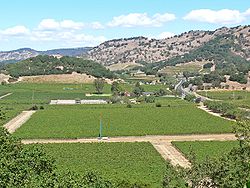
Back Weinbau in Kalifornien German Vino de California Spanish Vignoble de Californie French カリフォルニアワイン Japanese 캘리포니아 포도주 Korean Californische wijn Dutch California wine SIMPLE Kalifornijsko vino Serbian Kaliforniska viner Swedish Kaliforniya şarabı Turkish
California wine production has a rich viticulture history since 1680 when Spanish Jesuit missionaries planted Vitis vinifera vines native to the Mediterranean region in their established missions to produce wine for religious services. In the 1770s, Spanish missionaries continued the practice under the direction of the Father Junípero Serra who planted California's first vineyard at Mission San Juan Capistrano.[5][2]
Its contemporary wine production grew steadily since the end of Prohibition, but mostly known for its sweet, port-style and jug wine products. As the market favored French brands, California's table wine business grew modestly,[6] but quickly gained international prominence at the Paris Wine Tasting of 1976, when renown French oenophiles, in a blind tasting, ranked the California wines higher than the primer French labels in the Chardonnay (white) and Cabernet Sauvignon (red) categories.[7] The result caused a 'shock' in viticulture industry since France was regarded as foremost producer of the world's finest table wines. This event contributed to expanding the recognition and prestige of vintners in the New World, specifically, the "Golden State."[8]
The state produces about ninety percent of the American wine supply and is the fourth largest wine producer among the world's independent nations.[9][10] California has more than 4,200 wineries ranging from home-grown and small boutiques to large corporations with international distribution, and even more vineyards and growers, at close to 6,000.[9][11]
- ^ a b c d "California: Appellation Profile". Appellation America. 2007. Archived from the original on March 3, 2016.
- ^ a b Diaz, Jo (March 17, 2011). "The Mission Grape Played a Major Role in California Wine Viticultural History". Wine Blog.
- ^ "Established American Viticultural Areas" (California). Tax and Trade Bureau. Alcohol and Tobacco, Tax and Trade Bureau, Treasury. Retrieved February 23, 2024.
- ^ "Statistics".
- ^ Taber, George M. (2005). The Judgment of Paris: California vs France and the Historic 1976 Paris Tasting That Revolutionized Wine. Scribner. p. 32. ISBN 978-0-7432-4751-1.
- ^ Taber (2005), p. 40.
- ^ Taber (2005), pp. 216–220.
- ^ Peterson, Thane (May 8, 2001). "The Day California Wines Came of Age". Business Week. Archived from the original (Movable Feast) on October 18, 2007. Retrieved July 19, 2006.
- ^ a b MacNeil, Karen (2000). The Wine Bible. Workman Publishing. pp. 636–643. ISBN 978-1-56305-434-1.
- ^ Stevenson, Tom (2011). Sotheby's Wine Encyclopedia (5th ed.). Dorling Kindersley. p. 462. ISBN 978-0-7566-8684-0.
- ^ "Statistics - California Wine Profile 2021". California Wine Institute.
